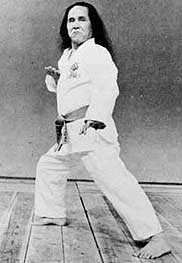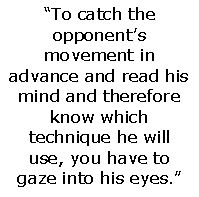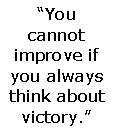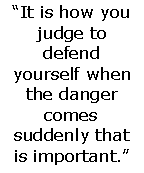Goju-Ryu Karate-Do Kyohan
Practice Fighting
by Yamaguchi Gogen "The Cat"
Editor's note: This article is the third in a three
part series excerpted from Yamaguschi's classic karate text, "Goju
Ryu Karate Do Kyohan: The History and Fundamentals of Goju-Ryu Karate,"
now in reprint. Previous articles in this series were "The
History and Fundamentals of Goju-Ryu Karate."and "The
Significance of Kata."
Before Starting Kumite (Practice Fighting)
In kumite, you use all the basic techniques, movements,
and kata for actual attacks and defenses.  There
is yakusoku kumite, in which the movements are performed by the book;
and jiyu-kumite, in which the movements are performed freely. There
is yakusoku kumite, in which the movements are performed by the book;
and jiyu-kumite, in which the movements are performed freely.
In either instance, the practice will be changed from a single practice
to a practice with more than one person so that there are many things
you have to pay attention to.
First of all, you have to choose the right opponent. The first condition
is, you should choose someone who is the same level as you are, or preferably
better than you are. You can see that when you practice the basics or
movements of kata, it is helpful if you have more than one person to practice
with because you can defend against many types of opponents.
The techniques and standing positions used in the practice of kumite
are the same as the practice of basic techniques; however, in jiyu kumite,
different techniques or standing positions can be used. Yet, the foundation
has to be the extension of the basics.
Although you did very well in individual practices and you have very
good basics, having an opponent in actual kumite is very difficult and
you cannot perform as you want. When you practice kumite, you have to
pay attention to the next points:
 First,
there has to be a certain distance. Even though you have a strong attacking
technique, if the distance is too far, the attack can fail. Kumite is
the combination of attack and defense, therefore, a one-sided performance
is useless. The timing has to match the opponent's movements. When you
use techniques in attacks and defenses in an actual fight, you have to
have kime-waza [timing] when you attack consciously. In the game, this
is the technique to gain the point. For the technique to be effective,
your mind will have to be enriched and it appears outwardly in your kiai
(shout). First,
there has to be a certain distance. Even though you have a strong attacking
technique, if the distance is too far, the attack can fail. Kumite is
the combination of attack and defense, therefore, a one-sided performance
is useless. The timing has to match the opponent's movements. When you
use techniques in attacks and defenses in an actual fight, you have to
have kime-waza [timing] when you attack consciously. In the game, this
is the technique to gain the point. For the technique to be effective,
your mind will have to be enriched and it appears outwardly in your kiai
(shout).
When you proceed with your techniques, speed is needed; however, if you
attack or change position continuously and recklessly, you cannot make
use of timing. For that reason, after you perform kime-waza (timing) as
zanshin (continuing spirit), you have to leave some place in your mind
to enrich your power.
Furthermore, to catch the opponent's movement in advance and read his
mind and therefore know which technique he will use, you have to gaze
into his eyes, which is called "me-tsuke."
(1) Yakusoku-kumite
Yakusoku-kumite is the performing of movements against an opponent structured
by the basics with an opponent by having the kind of techniques and the
directions arranged in advance. It is decided by how many techniques the
attacking side uses. It can be ippon-kumite [one-point kumite], nihon-kumite
[two-point kumite], or more. The most basic techniques, which are standing,
thrusting, and catching techniques, are used. It follows the basics, and
both have the same standing position -- if the opponent has the right
leg out in front, the other has the right leg out in front as well, or
if the opponent thrusts with the right hand, the other catches his hand
with his right hand. In yakusoku-kumite, the person who performs defense
will use attacking techniques at the end. On the other hand, there is
applied yakusoku kumite, in which the basic and applied techniques are
structured promisingly for use in an actual fight. The number of techniques
used are not limited in applied yakusoku-kumite; therefore, the number
of structures are uncountable. Still, this is promised kumite and is usually
performed by two people; however, there are practices in which three,
four, or even more people perform what is called applied kumite. When
applied kumite is practiced by many people, depending on how many are
involved, the person on the opposite side will be indicated.
(2) Jiyu-Kumite
 Jiyu-kumite
refers to the practice of using all the techniques you have learned until
now against an opponent. You cannot be off your guard even a second. This
is a very serious training method. If you do it for enjoyment, you can
get injured. Jiyu-kumite is not designed for deciding victory or defeat.
It is the practice of offense and defense with the development of the
techniques. You can not improve if you always think about victory. As
a matter of fact, you should not excite (or stimulate) your opponent more
than needed when you practice kumite. You have to respect any opponent
you have when you practice. Jiyu-kumite
refers to the practice of using all the techniques you have learned until
now against an opponent. You cannot be off your guard even a second. This
is a very serious training method. If you do it for enjoyment, you can
get injured. Jiyu-kumite is not designed for deciding victory or defeat.
It is the practice of offense and defense with the development of the
techniques. You can not improve if you always think about victory. As
a matter of fact, you should not excite (or stimulate) your opponent more
than needed when you practice kumite. You have to respect any opponent
you have when you practice.
In kumite, it is forbidden to attack your opponent with direct contact.
As a principle, any technique you use will have to be stopped before it
connects. However, when you are in defense, you have to practice as if
you are actually being attacked. Any injuries in kumite are usually because
of carelessness. Especially common is the injury of fingers when the fist
is opened. The fist needs to be firmly closed. Practicing using an open
hand should be restricted until you improve enough.
There are eight kyo (opportunities) to take advantage of when you attack:
-
Instantaneous kyo. Right before the opponent changes to the next
movement.
-
Right after the opponent has made a movement that was not effective.
-
When the opponent lacks harmony between the techniques used and his
mind, during both attack and defense.
-
When the opponent's mind is dispersed and is not really ready.
-
When the opponent loses his balance when he makes a movement.
-
Right before the opponent breathes in deeply.
-
When the opponent is confused because of your movement.
-
When the opponent is daunted by your tactics or ability.
The five unguarded moments you have to prevent when you are in defense:
-
The unguarded moment in the mind.
-
The unguarded moment in the spirit.
-
The unguarded moment in the technique.
-
The unguarded moment in the appearance.
-
The unguarded moment in the act. (The same as in normal life, if
you behave badly, you have to take responsibility for your actions.)
If you use techniques that do not follow the rule, that is faulty.
(3) Yakusoku-Kumite by More Than Two People
Usually, yakusoku-kumite is done by two people. One does the attack and
the other the defense. Practice by repeating the attacks and defenses
as the preceding stage of jiyu-kumite and shiai-kumite. I especially recommend
to students who have a black belt, or who are more than third-dan, to
practice yakusoku-kumite against two or three opponents, besides the one-on-one
practices. Jiyu-kumite and shiai-kumite (contest fighting) are both practiced
by two people. For that reason, some people interpret that the practice
against three or four people is the art of self-defense, which is unreasonably
emphasized in karate.
However, the purpose of practicing is to build up your strength in kumite,
and when you have many opponents, extreme reflexes are needed; therefore,
you will improve changing your positions and the continuous techniques
of uke (block) and tsuki (punch), technically and mentally.
 Practicing
is not done to win against many opponents, it is to grasp the opponents'
movements quickly and precisely and for yourself to gain the advantage.
Moreover, even though most of these techniques are simple ones, you have
to try hard to learn that these techniques can be useful and will eventually
be performed unconsciously by repeating them over and over. To learn that
when you have many opponents around you, that these opponents will take
the most advantageous place and that you will be in the middle, a disadvantageous
situation, will allow you to think and move with all your strength. Practicing
is not done to win against many opponents, it is to grasp the opponents'
movements quickly and precisely and for yourself to gain the advantage.
Moreover, even though most of these techniques are simple ones, you have
to try hard to learn that these techniques can be useful and will eventually
be performed unconsciously by repeating them over and over. To learn that
when you have many opponents around you, that these opponents will take
the most advantageous place and that you will be in the middle, a disadvantageous
situation, will allow you to think and move with all your strength.
(4) Kumite of Self-Defense for Women
Editor's note: While Yamaguchi's portrayal of women
in karate is not consistent with modern thinking in the west, his statements
are interesting from a historical point perspective and show that he progressive
in his thinking in a country once dominated by the male point of view.
Karate-do is spreading rapidly among men. As yet, there are not many
women who want to learn karate-do. However, recently, some women who are
interested in karate-do can be found here and there practicing in dojo.
Few women are practicing karate with men, especially in foreign countries.
There are classes just for women and more women are becoming interested
in karate-do.
Since ancient times, the practice of karate-do was very strict and designed
for fighting. For that reason, karate had unrelated techniques for women.
However, as the eras went by, karate-do modernized and now, it is thought
that through practicing kata many people start learning karate as a self-defense.
When women want to learn karate-do, the purpose is for self-defense as
explained above. The discipline acquired during the practice, character
building through courtesy, and the increased body strength are all beneficial.
From ancient times on, the techniques that are used for karate are adopted
to the dance of the East and the dance of Okinawa. In dance, the meaning
of the dance and the movements of the hands and legs of karate are taken
in an aesthetic sense. Especially, the harmony of the systematic movements
in a kata is worth performing without question, by both men and women.
Compared to the powerful performances by men, the elegant performances
by women can be equated to a dance. It is no exaggeration if I say there
are elements of the stillness you can see in Noh (Japanese ancient dance)
in the movements of karate, as well as the rhythm you can see in modern
dance and the delicate balance of Thai dance.
How To Practice for Women
Primarily, it was said that the women were weak and the violent movements
that men do was moderate among women. Now, as you can see in the Olympics,
women who train well exceed the average man. For that reason, it is not
unnatural for women to practice karate as men do; however, although women
have become stronger, there is a limit for women who fight in karate without
the benefit of any equipment.
It is important for women to get stronger mentally before they get physical
strength. In modern society, it is not allowed to put up with the idea
that you are a woman. In the work place, the responsibility must be the
same as well. Even though women are ladylike and cheerful in the modern
day, moderation, courtesy, and endurance are asked for. The training of
the body and mind are not only for men. The practice of the basics of
karate and the movements and discipline are needed. Still, although women
do vigorous exercises, they will not develop the strength of men.
In the practice of kata, you have to realize the importance of basics
and have to remember them precisely. It is important to practice self-defense
techniques with the attitude of passiveness. It is not the practice to
twist men around your finger. There are many ways to defend yourself.
It is how you judge to defend yourself when the danger comes suddenly
that is important, and you have to cope with the situation calmly without
panicking.
There is a proverb that says: "Discretion is the better part of
valor." Self-defense techniques for women is as the proverb says.
In the explanation of the techniques, they appear from the uke (block)
to the kime-waza, but if you have composure to throw down the opponent,
it is better to run away rather than fight. Half-confidence is a big mistake.
The important thing is not to go to a dangerous place, and avoid these
troubles to begin with.
Part 1: The History
and Fundamentals of Goju-Ryu Karate
Part 2: The Significance
of Kata
This excerpt from Yamaguchi's book, "Goju Ryu Karate Do Kyohan,"
was submitted by Masters Publications. This is the fourth book in the
Limited Edition series translated from Japanese into English and published
by Masters Publication; the first was "To-Te Jitsu" by Funakoshi
Gichin, followed by "Okinawan Kempo" by Motobu Choki and "Wado
Ryu Karate" by Otsuka Hiroki.
For more information contact:
Mastersline/Rising Sun Video Productions
310-477-7604 fx 310-383-3135
http://www.masterspub-mas.com/
Email: donrw@earthlink.net
|